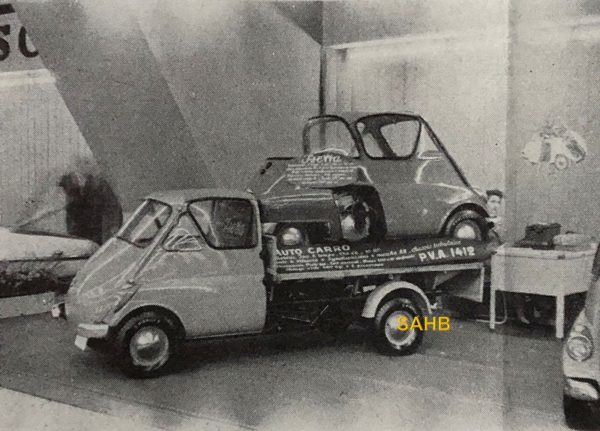
If adding a flat bed to a bubble car was not bizarre enough, this eight-wheeled combination of truck and car is guaranteed to raise a smile. It also gives the opportunity to tell the story of the car and its commercial derivatives.
In the early 1950s the Italian company Iso SpA was building refrigerators, motor scooters and small three-wheeled trucks. The company’s owner, Renzo Rivolta, decided to build a small car using the motorcycle engine of the Iso Moto 200. It was named Isetta.
It caused a sensation at its introduction to the press in Turin in November 1953. It was an entirely new concept: only 2.29 metres long and 1.37 metres wide, its entire front end hinged outwards for entry. In the event of a crash, the driver and passenger were supposed to exit through the canvas sunroof. The steering wheel and instrument panel swung out with the single door, easing access to the single bench seat. There was a parcel shelf behind, and a spare wheel located below. The importance of this in a unique Berlin-based version will become apparent later.
The car was powered by a 236 cc split-single two-stroke motorcycle engine, started by a combined generator-starter – a Dynastart. There were four forward speeds and reverse. A chain drive connected the gearbox to a solid rear axle with a pair of closely spaced 10-inch rear wheels with no need for a differential. The front axle had independent suspension. The Isetta took over 30 seconds to reach 31 mph from rest and had a top speed of about 47 mph. The fuel tank held only 2.9 gallons, but consumption was an impressively low 50-70 mpg.
In 1954, Iso entered five Isettas in the Mille Miglia, where they took the top three places in the economy classification and averaged 43 mph – the very definition of “flat out all the way.” Delightfully, the cars were numbered 2100 to 2104 – the time that they set off the previous evening to give them any chance of being near the finish when the leaders arrived. (Ascari’s winning car was 602, setting off nine hours later).
The Autocarro in our Snapshot was a commercial version with full-width conventional rear axle with differential and leaf springs, and a large tubular frame. It could carry a 500 kg (half-ton) load. It was offered in several body styles—a flatbed pickup, enclosed truck, a tilt-bed or even a fire engine—although some of these might not have been sold. The Autocarro was very popular in Italy, and more than 4,000 Autocarros were thought to have been built.
The Isetta was also made under licence in many countries, in particular Germany. BMW bought the licence and the body tooling in 1955, but Iso continued to build the Isetta in Spain until 1958.
And finally we come to 23 May 1963. Klaus-Günter Jacobi helped his best friend Manfred Koster flee East Germany by smuggling him across the Berlin Wall in a considerably modified BMW Isetta. The border guards knew that it is absolutely impossible to hide a person behind the front seat of an Isetta – but Jacobi and Koster did it.
Photo courtesy of The Richard Roberts Archive.







Leave a Comment